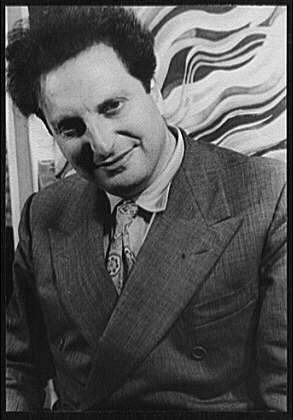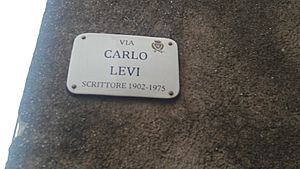Carlo Levi facts for kids
Quick facts for kids
Carlo Levi
|
|
|---|---|

Carlo Levi in 1947
(portrait by Carl Van Vechten) |
|
| Born | 29 November 1902 Turin, Italy
|
| Died | 4 January 1975 (aged 72) Rome, Italy
|
| Nationality | Italian |
| Education | Self taught, University of Turin (MD) |
| Known for | Painting, Literature, Medicine |
|
Notable work
|
Cristo si è fermato ad Eboli (Christ Stopped at Eboli) (1945) |
| Movement | Contemporary |
| Awards | Senator of the Italian Republic |
| Patron(s) | Felice Casorati |
Carlo Levi (born November 29, 1902 – died January 4, 1975) was a talented Italian painter, writer, and doctor. He was also an activist who cared deeply about his country.
He is most famous for his book Cristo si è fermato a Eboli (Christ Stopped at Eboli), published in 1945. This book shares his experiences when he was sent away to live in a poor, remote part of Italy called Lucania (also known as Basilicata). He was exiled there because of his political activities.
In 1979, his book was made into a movie with the same name. Lucania was one of the poorest areas in southern Italy. Levi's book helped people understand the difficult lives of the local farmers. It brought attention to the "Problem of the South" after World War II.
Contents
Carlo Levi's Early Life and Education
Carlo Levi was born in Turin, Piedmont, Italy. His family was wealthy, and his father was a doctor. His mother's brother, Claudio Treves, was an important socialist leader.
Carlo finished high school in 1917. He then went to the University of Turin to study medicine. He graduated in 1924 with excellent grades. At university, he became friends with Piero Gobetti. This friendship sparked his interest in political activism, which stayed with him his whole life.
Even though he studied medicine, Carlo Levi was also very interested in art. Soon after graduating, he showed some of his paintings at a big art show called the XIV Venice Biennale.
Levi continued his medical studies for a few years, working as an assistant at the University of Turin's Clinic. He also studied in Paris. However, by 1927, he decided to focus mostly on painting. In Paris, he met many famous people, including musicians like Sergei Prokofiev and Igor Stravinsky.
Fighting for Freedom: Carlo Levi's Activism
In 1929, Carlo Levi helped start an important group called Giustizia e Libertà (Justice and Freedom). This group was against fascism, a type of government that takes away people's freedoms. He became a leader of the Italian part of this group. He also joined a group of six painters in Turin called the "Gruppo dei Sei" (Group of six).
Because of his strong beliefs and his work against fascism, Levi was arrested. In 1935, he was sent away to live in two small, remote towns in Lucania: Aliano and Grassano. This was a form of punishment called exile.
In Lucania, he saw extreme poverty that was very different from the richer northern Italy. Even though he hadn't practiced medicine after medical school, he helped the villagers as a doctor. He also spent a lot of his time painting during his exile.
After he was released, he moved to France and lived there from 1939 to 1941. He returned to Italy in 1941 and was arrested again in Florence. He was put in Murate prison.
He was set free when Italy's leader, Benito Mussolini, was arrested. Levi then found a safe place to stay near the Pitti Palace in Florence. It was there that he wrote his famous book, Cristo si è fermato a Eboli.
Life After World War II

After World War II, Carlo Levi moved to Rome. From 1945 to 1946, he worked as the editor of L'Italia Libera. This was a newspaper for an anti-fascist group called the Partito d'Azione.
He continued to write books and paint, showing his art in Europe and the United States. Some of his other well-known books include L'Orologio (The Watch) and Le parole sono pietre (Words Are Stones).
In 1963, he was elected to the Senate, which is part of the Italian government. He was re-elected in 1968 and served until 1972. He was part of the Italian Communist Party.
Carlo Levi passed away in Rome on January 4, 1975, from pneumonia. He is buried in Aliano, the town where he was exiled. His very last painting, Apollo and Daphne, was done on a goatskin drum the day before he went to the hospital.
Carlo Levi's Books and Artworks
Here is a list of Carlo Levi's main books:
- Paura della pittura (1942)
- Cristo si è fermato a Eboli (Einaudi, 1945)
- Paura della libertà (1946)
- L'orologio (Einaudi, 1950)
- Le parole sono pietre (Einaudi, 1955)
- II futuro ha un cuore antico (Einaudi, 1956; won the Premio Viareggio, a literary award)
- La doppia notte dei tigli (Einaudi, 1959)
- Un volto che ci somiglia (Ritratto dell'Italia) (Einaudi, 1960)
- Tutto il miele è finito (Einaudi, 1964)
- Quaderno a cancelli (Einaudi, 1979; published after he died)
- Coraggio dei miti (Scrìtti contemporanei 1922–1974) (De Donato, 1975; published after he died)
- Carlo Levi inedito: con 40 disegni della cecità, Donato Sperduto (ed.), Edizioni Spes, Milazzo, 2002.
Carlo Levi also wrote many introductions for other authors' books. After he passed away, some of his essays and poems were also published.
Images for kids
-
Levi's huge painting Lucania 61 (1961), in Palazzo Lanfranchi in Matera
See also
 In Spanish: Carlo Levi para niños
In Spanish: Carlo Levi para niños








